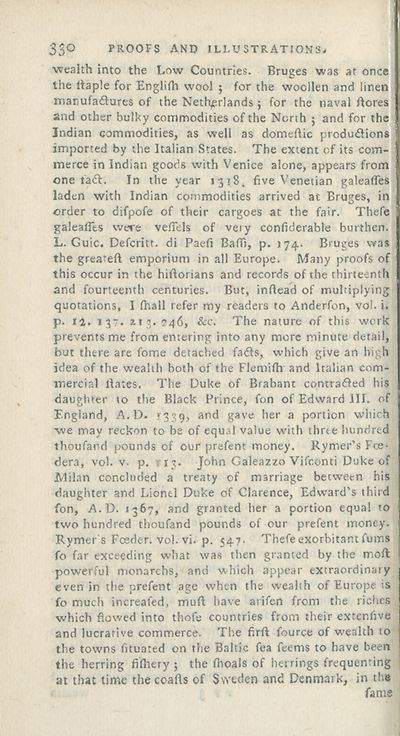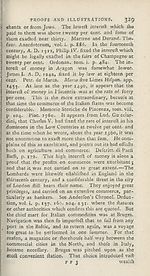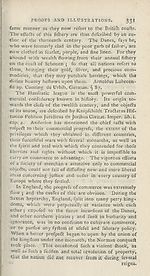Download files
Complete book:
Individual page:
Thumbnail gallery: Grid view | List view

350 PROOFS AND ILLUSTRATIONS.
•wealth into the Low Countries. Bruges was at once
the Itaple for Englifli wool ; for the woollen and linen
manufaflures of the Netherlands ; for the naval Acres
and other bulky commodities of the North ; and for the
Indian commodities, as well as domeftic produflions
imported by the Italian States. The extent of its com¬
merce in Indian goods with Venice alone, appears from
one faft. In the year 1318. five Venetian galealfes
laden with Indian commodities arrived at Bruges, in
order to difpofe of their cargoes at the fair. Thefe
galeafits were vefiels of very confiderable burthen.
L. Guic. Defcritt. di Paefi Baffi, p. 174. Bruges was
the greateft emporium in all Europe. Many proofs of
this occur in the hirtorians and records of the thirteenth
and fourteenth centuries. But, inftead of multiplying
quotations, I (hall refer my readers to Anderfon, vol. i.
p. ia. 137. atj. 746, &c. The nature of this work
prevents me from entering into any more minute detail,
but there are fome detached fadls, which give an high
idea of the wealth both of the Flemifh and Italian com¬
mercial llates. The Duke of Brabant contrafled his
daughter to the Black Prince, fon of Edward III. of
England, A. D. rgtg, and gave her a portion which
■we may reckon to be of equal value with three hundred
thoufand pounds of our prefent money. Kymer’s Fee¬
der.!, vol. v- p. nj. John Galeazzo Vifc.onti Duke of
Milan concluded a treaty of marriage between his
daughter and Lionel Duke of Clarence, Edward’s third
fon, A. D. 1367, and granted her a portion equal to
two hundred thoufand pounds of our prefent money.
Rymer s Feeder, vol. vi. p. 547. Thefe exorbitant fums
fo far exceeding what was then granted by the moft
powerful monarchs, and which appear extraordinaty
even in the prefent age when the wealth of Europe is
fo much increafed, muft have atifen from the riches
which flowed into thofe countries from their extenfive
and lucrative commerce. The firft fource of wealth to
the towns fituated on the Baltic fea feems to have been
the herring fifhery ; the fhoals of herrings frequenting
at that time thecoafis of Sweden and Denmaik, in the
fame
•wealth into the Low Countries. Bruges was at once
the Itaple for Englifli wool ; for the woollen and linen
manufaflures of the Netherlands ; for the naval Acres
and other bulky commodities of the North ; and for the
Indian commodities, as well as domeftic produflions
imported by the Italian States. The extent of its com¬
merce in Indian goods with Venice alone, appears from
one faft. In the year 1318. five Venetian galealfes
laden with Indian commodities arrived at Bruges, in
order to difpofe of their cargoes at the fair. Thefe
galeafits were vefiels of very confiderable burthen.
L. Guic. Defcritt. di Paefi Baffi, p. 174. Bruges was
the greateft emporium in all Europe. Many proofs of
this occur in the hirtorians and records of the thirteenth
and fourteenth centuries. But, inftead of multiplying
quotations, I (hall refer my readers to Anderfon, vol. i.
p. ia. 137. atj. 746, &c. The nature of this work
prevents me from entering into any more minute detail,
but there are fome detached fadls, which give an high
idea of the wealth both of the Flemifh and Italian com¬
mercial llates. The Duke of Brabant contrafled his
daughter to the Black Prince, fon of Edward III. of
England, A. D. rgtg, and gave her a portion which
■we may reckon to be of equal value with three hundred
thoufand pounds of our prefent money. Kymer’s Fee¬
der.!, vol. v- p. nj. John Galeazzo Vifc.onti Duke of
Milan concluded a treaty of marriage between his
daughter and Lionel Duke of Clarence, Edward’s third
fon, A. D. 1367, and granted her a portion equal to
two hundred thoufand pounds of our prefent money.
Rymer s Feeder, vol. vi. p. 547. Thefe exorbitant fums
fo far exceeding what was then granted by the moft
powerful monarchs, and which appear extraordinaty
even in the prefent age when the wealth of Europe is
fo much increafed, muft have atifen from the riches
which flowed into thofe countries from their extenfive
and lucrative commerce. The firft fource of wealth to
the towns fituated on the Baltic fea feems to have been
the herring fifhery ; the fhoals of herrings frequenting
at that time thecoafis of Sweden and Denmaik, in the
fame
Set display mode to:
![]() Universal Viewer |
Universal Viewer | ![]() Mirador |
Large image | Transcription
Mirador |
Large image | Transcription
| Antiquarian books of Scotland > Kings & rulers > History of the reign of the Emperor Charles V. > Volume 1 > (348) |
|---|
| Permanent URL | https://digital.nls.uk/109186507 |
|---|
| Description | By William Robertson. London : Cadell and Davies, 1798. |
|---|---|
| Shelfmark | ABS.1.76.13 |
| Additional NLS resources: | |
| Description | Thousands of printed books from the Antiquarian Books of Scotland collection which dates from 1641 to the 1980s. The collection consists of 14,800 books which were published in Scotland or have a Scottish connection, e.g. through the author, printer or owner. Subjects covered include sport, education, diseases, adventure, occupations, Jacobites, politics and religion. Among the 29 languages represented are English, Gaelic, Italian, French, Russian and Swedish. |
|---|

